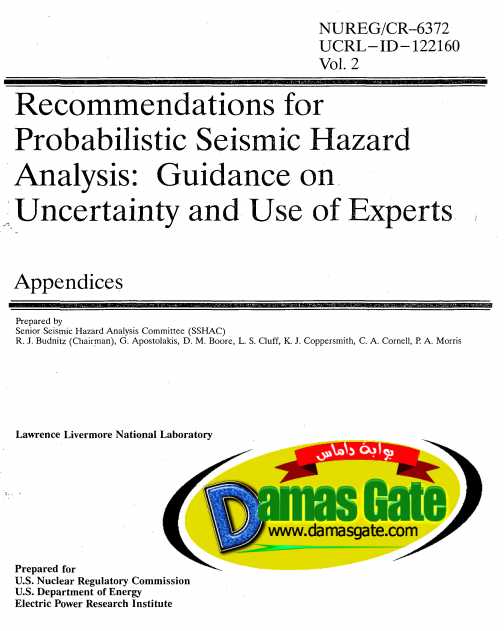Recommendations for Probabilistic Seismic Hazard Analysis Guidance on Uncertainty and Use of Experts vol 2

ABSTRACT
Probabilistic Seismic Hazard Analysis (PSHA) is a methodology that estimates the likelihood that various
levels of earthquake-caused ground motion will be exceeded at a given location in a given future time
period. Due to large uncertainties in all the geosciences data and in their modeling, multiple model
interpretations are often possible. This leads to disagreement among experts, which in the past has led to
disagreement on the selection of ground motion for design at a given site.
In order to review the present state-of-the-art and improve on the overall stability of the PSHA process,
the U.S. Nuclear Regulatory Commission (NRC), the U.S. Department of Energy (DOE), and the Electric
Power Research Institute (EPRI) co-sponsored a project to provide methodological guidance on how to perform a PSHA.
The project has been carried out by a seven-member Senior Seismic Hazard Analysis Committee
(SSHAC) supported by a large number other experts.
The SSHAC reviewed past studies, including the Lawrence Livermore National Laboratory and the EPRI
landmark PSHA studies of the 1980's and examined ways to improve on the present state-of-the-art.
The Committee's most important conclusion is that differences in PSHA results are due to procedural
rather than technical differences. Thus, in addition to providing a detailed documentation on state-of-theart elements of a PSHA, this report provides a
series of procedural recommendations.
The role of experts is analyzed in detail. Two entities are formally defined-the Technical Integrator (TI)
and the Technical Facilitator Integrator (TFI)-to account for the various levels of complexity in the
technical issues and different levels of efforts needed in a given study.
Download
*